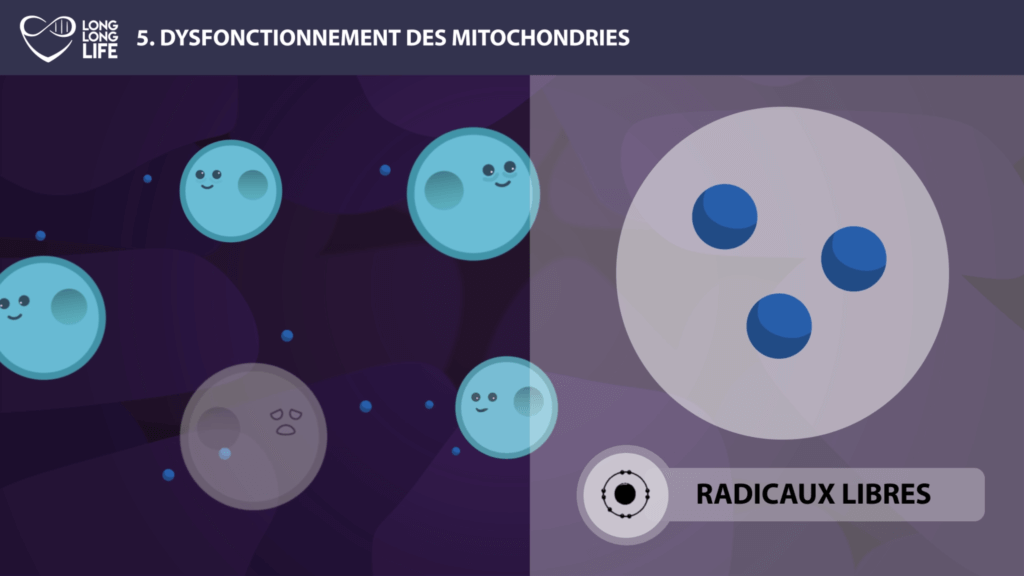Part 5: The 9 causes of aging - Mitochondrial dysfunction

In our series on the 9 causes of aging, we are going to address here a fifth identified cause of aging: mitochondrial dysfunction.
For other causes of aging, click here!
Mitochondria: definition
Mitochondria are organelles present in each of your cells. Their role is to maintain cellular respiration and the creation of ATP (adenosine triphosphate), which is the main source of energy essential for all mechanisms of the human body . In short, mitochondria are the energy powerhouses of your cells.
Note that, apart from the nucleus, mitochondria are the only organelles in your cells to have their own DNA, this is called mitochondrial DNA. So in each of your cells, you not only have the DNA of the nucleus, transmitted by both of your parents, but also the DNA of your mitochondria, transmitted by your biological mother. However, not all of the proteins found inside your mitochondria that allow them to function come from mitochondrial DNA.
To better understand the phenomenon, studies have been carried out on the evolution of the functioning of mitochondria at different stages of life. These studies showed that mitochondrial dysfunction was not only a marker of aging, but occurred without any significant modification being observed in mitochondrial DNA. This suggests that a mutation in mitochondrial DNA is not the only cause of age-related mitochondrial dysfunction, and that it is due to one or more other phenomena.
Mitochondria and free radicals
|
So, who are our suspects? Firstly, oxidative stress. It is a mechanism which involves, among other things, molecules called free radicals. These free radicals have, as their name suggests, atoms free to fix other molecules by oxidation and thus create damage to your cells. Aging has long been linked to wear caused by oxidation, but the reality is perhaps more complex. Recent studies have in fact shown that increasing the levels of antioxidants, which fight free radicals, had no effect on life expectancy, whereas by increasing the level of free radicals in certain models, we could increase the lifespan. |
 |
 |
A possible explanation: this oxidative stress would force the activation of potentially beneficial regeneration mechanisms, such as autophagy, which we mentioned previously. Remember, autophagy is above all a means of defense for your cells: when an organelle no longer functions well, the cell will cannibalize it to allow its survival. Autophagy of damaged mitochondria, also called mitophagy, is the main pathway for eliminating these mitochondria. Free radicals released by oxidative stress could generate a beneficial survival signal. |
In theory, it is now assumed that during aging, cellular stress and the number of cell lesions would increase. The levels of free radicals in the body would increase at the same time, in order to preserve the organism. Beyond a certain point, these levels would cease to maintain cellular balance and could worsen problems associated with age.
The role of free radicals is therefore not yet clear to scientists, it is a question which is really debated.

Mitochondria: intercellular communication
The second cause that links mitochondria to aging could be the communication between the nucleus of the cell and its mitochondria.
This communication is necessary for the replication of the mitochondrion, so it is essential for the cell. With aging, communications between the nucleus and mitochondria deteriorate. This poor communication can lead to the deterioration of the mitochondria, a phenomenon which in turn causes the cell to age due to a reduction in available energy.
Mitochondria: mutations in mitochondrial DNA
And finally, it is not excluded that mutations in our mitochondrial DNA also come into play. So we're going to talk about them a little, even if they are not necessarily predominant.
The involvement of mitochondrial DNA mutations in the aging process has been proven: it has been shown that deterioration of mitochondrial DNA can cause premature aging and reduce lifespan.
Although the impact of these mutations is not as deleterious as mutations in nuclear DNA, scientists believe it is likely that mitochondrial DNA is more susceptible to mutations. Indeed, a mitochondria, a sort of energy center of your cells, is not a comfortable area to avoid genetic mutations. Especially since the repair mechanisms of mitochondrial DNA are much less evolved than those of nuclear DNA.
However, rest assured, unlike nuclear DNA, there are several hundred mitochondria in each of your cells. However, the numerous copies of mitochondrial DNA in each of your cells probably mitigate the consequences of damage to this type of DNA. Despite this, it has been proven that the number of mitochondria decreases with age in the liver cells of mice, rats and humans, and therefore, the amount of mitochondrial DNA would decrease over time.
In summary, the accumulation of mutations at the heart of the mitochondrial genome could gradually take an increasingly important role in the aging process.
SOURCES:
Dr. Guilhem Velvé Casquillas on http://www.longlonglife.org/

